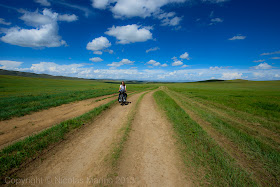It is a tale
Even so, taking a wrong track becomes a habit, but paradoxically, it does not cause a problem. It’s just a setback that is taken usually with satisfaction, because, regardless of the direction in which you go, everything around is so beautiful that the experience never fails to be comforting.
Even the trails may occasionally disappear completely, but as long as one follows the compass according to what one reads on the map, there is no problem, the grass is so soft, that one can directly roll over it until you find a new track.
In the midst of this infinite green velvet mantle, apparently solitary and silent, life vibrates. The horses, sheep, cows, goats are the true blood of Mongolia. Their nomads roam huge portions of the country by moving from side to side looking for the best pastures, as they have been doing for centuries. They are the ones who throughout history have gradually traced the furrows on the grass that today link the whole country.
On them, we cycled unnoticed and without haste through the aimags (provinces) of Töv and Bulgan, absorbing, as sponges, the immeasurable beauty and breathing the peace of a serene life going on around us. Mongolia induces a slow and leisurely pace. There are little or no excuses at all to go fast, quite the contrary, it causes the feeling of wanting to stay there, at a standstill in time, going slowly, very slowly, watching life go by in the form of animals grazing peacefully and the nomads on horseback leading their herds.
The summer days are long; the sun sets after 9 pm but it is only after 10 pm that full darkness finally sets in. The arrival of sunset is the crowning moment for which one pedals all day long, when the sun in its slow descent bathes in gold this immense green carpet, casting soft and extensive shadows, leading to a myriad of different hues and plays of light and shade. If during the day beauty abounds, it is in the twilight, when it overwhelms the senses and cloys. It's time to stop, to seek our encounter with the nomads and approach their gers asking for permission to camp nearby.All is left is pitching the tent, making some tea and lying on the softness of the grass to let yourself plunge into the spectacle of the end of the day while waiting for the sky to be painted by millions of stars.








No comments:
Post a Comment